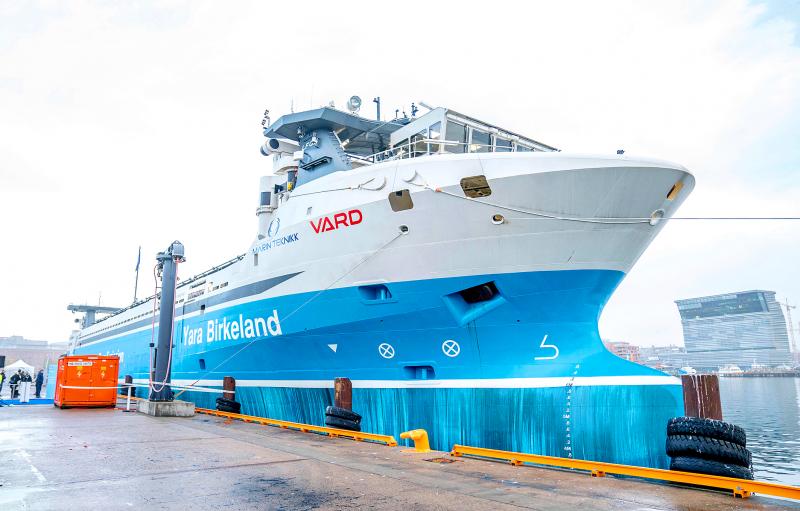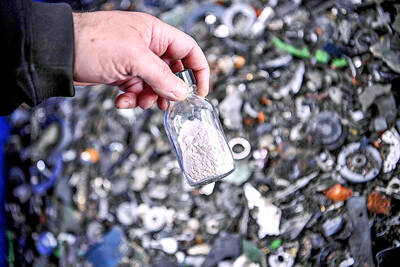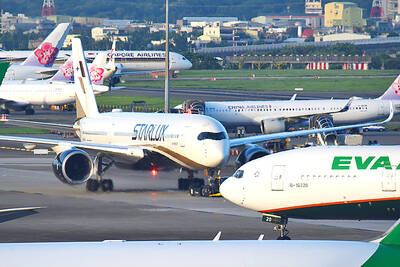Zero emissions and, soon, zero crew: The world’s first fully electric autonomous cargo vessel was unveiled in Norway, a small but promising step toward reducing the maritime industry’s climate footprint.
By shipping up to 120 containers of fertilizer from a plant in the southeastern town of Porsgrunn to Brevik’s port 12km away, the much-delayed Yara Birkeland, shown off to the media on Friday, would eliminate the need for about 40,000 truck journeys a year that are now fueled by polluting diesel.
“Of course, there have been difficulties and setbacks, but then it feels even more rewarding to stand here today in front this ship and see that we were able to do it,” said Svein Tore Holsether, chief executive of Norwegian fertilizer giant Yara International ASA, with the sleek blue-and-white vessel moored behind him in an Oslo dock, where it had been sailed for the event.

Photo: AFP
The 80m, 3,200 deadweight tonne ship is soon to begin two years of working trials, during which it would be fine-tuned to learn to maneuver on its own.
The wheelhouse could disappear altogether in “three, four or five years,” said Holsether, once the vessel makes its 7.5 nautical mile (13.89km) trips on its own with the aid of sensors.
“Quite a lot of the incidents happening on vessels are due to human error, because of fatigue for instance,” Yara International project manager Jostein Braaten said.

Photo: AFP
“Autonomous operating can enable a safe journey,” he added.
While the distance the Yara Birkeland would cover might be short, there would be many obstacles.
It would have to navigate in a narrow fjord, and sail under two bridges while managing currents and heavy traffic from merchant ships, pleasure craft and kayaks, before docking at one of Norway’s busiest ports.
The next few months are to be a learning period.
“First of all, we have to detect that there’s something there. We have to understand that it’s a kayak, then we have to determine what to do with that,” Braaten said.
“Currently, large vessels don’t do much with a kayak. They can’t do much. They can warn, but they cannot maneuver away” or reverse to avoid an incident, he said.
Autonomous navigation woud require a new set of regulations that do not exist yet.
On the Yara Birkeland, the traditional machine room has been replaced by eight battery compartments, giving the vessel a capacity of 6.8 megawatt hours (MWh) — sourced from renewable hydroelectricity.
“That’s the equivalent of 100 Teslas,” Braaten said.
The maritime sector, which is responsible for almost three percent of all man-made emissions, aims to reduce its emissions by 40 percent by 2030 and 50 percent by 2050.
Despite that, the sector has seen a rise in the past few years.
International and domestic shipping and fishing combined, the industry emitted more than 1 billion tonnes of greenhouse gases in 2018, up from 962 million tonnes in 2012, International Maritime Organization figures showed.
By itself, the Yara Birkeland’s contribution to global climate efforts would be just a drop in the ocean — eliminating 678 tonnes of carbon dioxide per year churned out by the redundant trucks.
Experts also do not expect electric vessels to become a universal solution for the industry any time soon.
“Electricity has a ‘niche’ use, in particular for ferries as these are often short and stable routes, possibly on coastal and river transports, but it’s not well-adapted for long ocean crossings,” said Camille Egloff, a maritime transport expert at Boston Consulting Group.
“Not only would [a vessel] need to be autonomous for long distances, but you would also have to equip ports with battery chargers, so there are technical and infrastructure challenges that would need to be coordinated,” she said.
While dozens of electric ferries already criss-cross the fjords of Norway — a major oil and gas producer which is paradoxically also a leader in electric transport — ocean liners would have to rely on other technologies to go green, such as liquified natural gas, e-methanol and hydrogen.

RECYCLE: Taiwan would aid manufacturers in refining rare earths from discarded appliances, which would fit the nation’s circular economy goals, minister Kung said Taiwan would work with the US and Japan on a proposed cooperation initiative in response to Beijing’s newly announced rare earth export curbs, Minister of Economic Affairs Kung Ming-hsin (龔明鑫) said yesterday. China last week announced new restrictions requiring companies to obtain export licenses if their products contain more than 0.1 percent of Chinese-origin rare earths by value. US Secretary of the Treasury Scott Bessent on Wednesday responded by saying that Beijing was “unreliable” in its rare earths exports, adding that the US would “neither be commanded, nor controlled” by China, several media outlets reported. Japanese Minister of Finance Katsunobu Kato yesterday also

China Airlines Ltd (CAL, 中華航空) said it expects peak season effects in the fourth quarter to continue to boost demand for passenger flights and cargo services, after reporting its second-highest-ever September sales on Monday. The carrier said it posted NT$15.88 billion (US$517 million) in consolidated sales last month, trailing only September last year’s NT$16.01 billion. Last month, CAL generated NT$8.77 billion from its passenger flights and NT$5.37 billion from cargo services, it said. In the first nine months of this year, the carrier posted NT$154.93 billion in cumulative sales, up 2.62 percent from a year earlier, marking the second-highest level for the January-September

‘DRAMATIC AND POSITIVE’: AI growth would be better than it previously forecast and would stay robust even if the Chinese market became inaccessible for customers, it said Taiwan Semiconductor Manufacturing Co (TSMC, 台積電) yesterday raised its full-year revenue growth outlook after posting record profit for last quarter, despite growing market concern about an artificial intelligence (AI) bubble. The company said it expects revenue to expand about 35 percent year-on-year, driven mainly by faster-than-expected demand for leading-edge chips for AI applications. The world’s biggest contract chipmaker in July projected that revenue this year would expand about 30 percent in US dollar terms. The company also slightly hiked its capital expenditure for this year to US$40 billion to US$42 billion, compared with US$38 billion to US$42 billion it set previously. “AI demand actually

Jensen Huang (黃仁勳), founder and CEO of US-based artificial intelligence chip designer Nvidia Corp and Taiwan Semiconductor Manufacturing Co (TSMC, 台積電) on Friday celebrated the first Nvidia Blackwell wafer produced on US soil. Huang visited TSMC’s advanced wafer fab in the US state of Arizona and joined the Taiwanese chipmaker’s executives to witness the efforts to “build the infrastructure that powers the world’s AI factories, right here in America,” Nvidia said in a statement. At the event, Huang joined Y.L. Wang (王英郎), vice president of operations at TSMC, in signing their names on the Blackwell wafer to